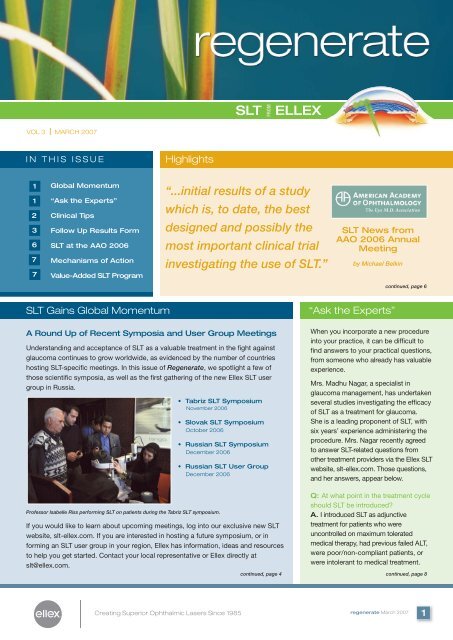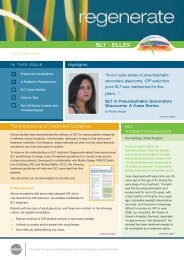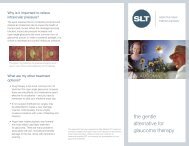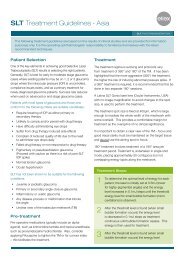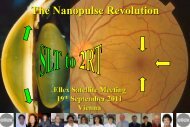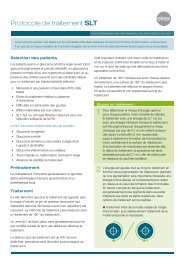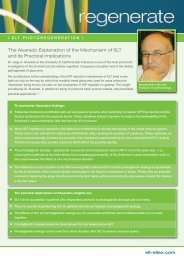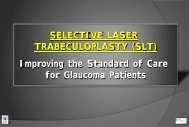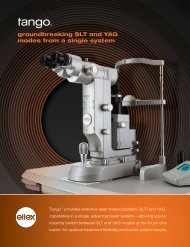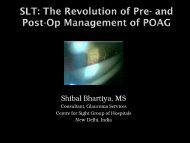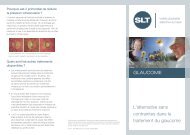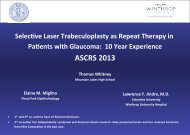SLT newsletter 3 updated.indd - SLT for Glaucoma | Ellex
SLT newsletter 3 updated.indd - SLT for Glaucoma | Ellex
SLT newsletter 3 updated.indd - SLT for Glaucoma | Ellex
- No tags were found...
Create successful ePaper yourself
Turn your PDF publications into a flip-book with our unique Google optimized e-Paper software.
<strong>SLT</strong> ELLEXFROMVOL 3 I MARCH 2007IN THIS ISSUEHighlights11236Global Momentum“Ask the Experts”Clinical TipsFollow Up Results Form<strong>SLT</strong> at the AAO 2006“...initial results of a studywhich is, to date, the bestdesigned and possibly themost important clinical trial<strong>SLT</strong> News fromAAO 2006 AnnualMeeting77Mechanisms of ActionValue-Added <strong>SLT</strong> Programinvestigating the use of <strong>SLT</strong>.”by Michael Belkincontinued, page 6<strong>SLT</strong> Gains Global Momentum“Ask the Experts”A Round Up of Recent Symposia and User Group MeetingsUnderstanding and acceptance of <strong>SLT</strong> as a valuable treatment in the fight againstglaucoma continues to grow worldwide, as evidenced by the number of countrieshosting <strong>SLT</strong>-specific meetings. In this issue of Regenerate, we spotlight a few ofthose scientific symposia, as well as the first gathering of the new <strong>Ellex</strong> <strong>SLT</strong> usergroup in Russia.• Tabriz <strong>SLT</strong> SymposiumNovember 2006• Slovak <strong>SLT</strong> SymposiumOctober 2006• Russian <strong>SLT</strong> SymposiumDecember 2006• Russian <strong>SLT</strong> User GroupDecember 2006When you incorporate a new procedureinto your practice, it can be difficult tofind answers to your practical questions,from someone who already has valuableexperience.Mrs. Madhu Nagar, a specialist inglaucoma management, has undertakenseveral studies investigating the efficacyof <strong>SLT</strong> as a treatment <strong>for</strong> glaucoma.She is a leading proponent of <strong>SLT</strong>, withsix years’ experience administering theprocedure. Mrs. Nagar recently agreedto answer <strong>SLT</strong>-related questions fromother treatment providers via the <strong>Ellex</strong> <strong>SLT</strong>website, slt-ellex.com. Those questions,and her answers, appear below.Professor Isabelle Riss per<strong>for</strong>ming <strong>SLT</strong> on patients during the Tabriz <strong>SLT</strong> symposium.If you would like to learn about upcoming meetings, log into our exclusive new <strong>SLT</strong>website, slt-ellex.com. If you are interested in hosting a future symposium, or in<strong>for</strong>ming an <strong>SLT</strong> user group in your region, <strong>Ellex</strong> has in<strong>for</strong>mation, ideas and resourcesto help you get started. Contact your local representative or <strong>Ellex</strong> directly atslt@ellex.com.Q: At what point in the treatment cycleshould <strong>SLT</strong> be introduced?A. I introduced <strong>SLT</strong> as adjunctivetreatment <strong>for</strong> patients who wereuncontrolled on maximum toleratedmedical therapy, had previous failed ALT,were poor/non-compliant patients, orwere intolerant to medical treatment.continued, page 4 continued, page 8Creating Superior Ophthalmic Lasers Since 1985regenerate March 20071
Clinical TipsEnping Chen, MD, Stockholm, SwedenDr. Enping Chen is an Associate Professor at <strong>Glaucoma</strong> Service <strong>for</strong> St. Erik’s EyeHospital at the Karolinska Institute in Stockholm, Sweden. He per<strong>for</strong>ms approximately 12<strong>SLT</strong> treatments per week, and has treated over 2,000 <strong>SLT</strong> patients since 2001. In 2005,Dr. Chen undertook a clinical study to investigate the efficacy of 180-degree treatmentversus 90-degree treatment.Tips <strong>for</strong> Use of Selective Laser TrabeculoplastyIt is important to provide patients with educational in<strong>for</strong>mation on <strong>SLT</strong> so that they willunderstand the purpose, the procedure and the risk of complications associated with <strong>SLT</strong>IEnping Chen, MDbe<strong>for</strong>e undergoing treatment.Treatment should be per<strong>for</strong>med just below the level of energy at which champagne bubblesare <strong>for</strong>med. To do this, determine the level of energy required <strong>for</strong> bubble <strong>for</strong>mation andthen reduce it by 0.1mJ be<strong>for</strong>e beginning treatment. For trabecular meshwork withoutpigmentation, it could be difficult to see the air bubbles. An energy level of 1.2-1.4 mJ isusually enough in this case.Dr. Ivan Goldberg is a Clinical Associate Professor at the University of Sydney and Director of the Eye Associates, Sydney,Adjust the energy level during treatment according to the pigmentation of the trabecularmeshwork.<strong>SLT</strong> may be per<strong>for</strong>med with 25 laser effects on 90 degrees of the trabecular meshwork.If the target pressure is not achieved, the treatment may be per<strong>for</strong>med in another quadrantafter a couple of months.Anti-inflammatory agents are not necessary in most cases.Preventive hypotensive agents are not necessary in most cases.<strong>SLT</strong> <strong>for</strong> Primary Angle-Closure <strong>Glaucoma</strong> Study Update2006 saw the completion of the final patientfollow-up in the multi-center, multi-countryclinical study on <strong>SLT</strong> <strong>for</strong> primary angleclosureglaucoma (PACG).Involving six centers throughout SoutheastAsia, the study was a prospectiveobservational, non-randomised pilot caseseriesstudy to determine the efficacy of<strong>SLT</strong> in achieving a significant reductionof intraocular pressure (IOP) <strong>for</strong> patientswith PACG who have open angle followingperipheral iridotomy, but persistentelevation of IOP.A strict protocol was devised to ensure ahomogeneous patient cohort, and requiredfollow-up periods of one day, one week,four weeks, three months and six months.Each study site used either an <strong>Ellex</strong> Tango or Solo <strong>SLT</strong> laser system to per<strong>for</strong>m <strong>SLT</strong>.Preliminary data appears promising andwas presented at various meetings during2006, including the APAO Congress inSingapore, Thai Ophthalmology Congressin Bangkok, SEAGIG Meeting in Chennaiand the Taiwan Ophthalmology SocietyMeeting in Taipei.At the completion of the last follow-up inDecember 2006, over 50 PACG patientswith residual glaucoma and increasedIOP glaucoma had been recruited andtreated with <strong>SLT</strong>. Data is currently beinganalyzed, with a clinical paper anticipated<strong>for</strong> publication shortly.If the finalized study results indicate apositive outcome, it may provide insightinto what could possibly be a newindication <strong>for</strong> <strong>SLT</strong>, as well as anothertreatment option <strong>for</strong> PACG patients.2regenerate March 2007
Analyzing <strong>SLT</strong> results using “<strong>SLT</strong> Follow Up Results Form”Javier González Rodríguez, MD, Vigo, SpainAt the recent SOE Congress, I presented a studythat showed Selective Laser Trabeculoplasty (<strong>SLT</strong>)to be an effective and safe method <strong>for</strong> controllingIOP in patients with primary open angle glaucoma(POAG). The study outlined the results of a twoyearprospective, non-randomized study investing<strong>SLT</strong> on 280 eyes (186 patients).A precise analysis was per<strong>for</strong>med to compare the efficacy of<strong>SLT</strong> treatment on different subgroups of patients, e.g., patientswith ALT or filtering surgery history.The entire group of patients included primary open angleglaucoma (39.3 percent), pseudoexfoliative glaucoma (23.2percent), ocular hypertension (15.3 percent) and secondaryglaucoma (11.4 percent). In all patients, data and treatmentparameters were recorded to per<strong>for</strong>m a retrospective analysisand comparison.The global success rate was analyzed using two criteria:1. IOP reduction superior or equal to 3 mmHg2. IOP reduction superior or equal to 20 percentThe best results were obtained <strong>for</strong> the subgroup with ocularhypertension and initial glaucoma, i.e., without glaucomasurgery history and a pressure superior to 21 mmHg withoutmedical treatment. The average pressure reduction on thatsubgroup ranged from 6.2 mmHg at three months to 5.9 mmHgat 24 months.Comparison of IOP reduction between patients withprevious ALT and those without previous ALT25201510Base Post 1dayprevious ALT1week2weeksno previous ALT1month2months3months6months9months12months18months24monthsGraph comparing IOP reduction over 24 month period in patients who haveundergone pervious ALT with those patients who have not undergone previous ALT(Source: Doctor Rodriguez, Spain).One of the interesting comparisons per<strong>for</strong>med was betweensubgroups with and without ALT history. This analysis showsthe similar efficacy of <strong>SLT</strong> treatment in both groups, as well asthe interest of <strong>SLT</strong> <strong>for</strong> patients who have had failed ALT.This analysis shows the good global response of patients, witha success rate close to 82 percent at 24 months.Global success rate of selective laser trabeculoplasty908070605040302010079.968.483.380.5 79.168.8 68.072.5Criterion 1 Criterion 275.968.582.482.43 months 6 months 9 months 12 months 18 months 24 months1401201008060Graph representing percentage success rate of <strong>SLT</strong> according to IOP reductionsuperior or equal to 3 mmHg, and IOP reduction superior or equal to 20 percent(Source: Doctor Rodriguez, Spain).40Doctor Javier González Rodríguez200 5mmHg140120100Editor’s Note: This study was statistically analyzed using the “<strong>SLT</strong> Follow Up Results Form,” developed80by Doctor Javier Gonzalez Rodriguez, which uses patient data and treatment parameter in<strong>for</strong>mation to60automatically generate graphs and statistical analysis of the clinical results. This <strong>for</strong>m, which can be used in40routine 20 practice or <strong>for</strong> tracking results of clinical studies, is now available <strong>for</strong> download at slt-ellex.com.0 5mmHgregenerate March 20073
<strong>SLT</strong> Gains Global Momentum, continuedTabriz <strong>SLT</strong> SymposiumNearly 40 people attended a November 27 <strong>SLT</strong> symposium organized by <strong>Ellex</strong> and Teb Tasvir in Tabriz, Iran. The meeting proved sopopular, in fact, that several last minute, unregistered attendees had to be turned away due to space constraints. Teb Tasvir CEO SaeedYasdani hosted the meeting, which started with a presentation by Christine Warren, <strong>Ellex</strong>. Ms. Warren introduced <strong>Ellex</strong> and discussedthe company’s commitment to making <strong>SLT</strong> more widely available <strong>for</strong> treating the growing number of glaucoma patients worldwide.Next, Dr. Behzad Fallahi of the Nikoukari Eye Hospital in Tabriz gave a thorough overview of the <strong>SLT</strong> technique, includingits advantages over ALT. This provided an introduction to guest speaker Professor Isabelle Riss, head of anterior segmentdepartment in Bordeaux University Hospital, France. In her presentation, she discussed the importance of early diagnosis ofglaucoma to enable early treatment given that a safe and effective treatment option with no side effects is now available – evenof younger people who are potentially at risk of developing the disease.Then, Professor Riss, a glaucoma specialist and accomplished cataract and glaucoma surgeon,per<strong>for</strong>med <strong>SLT</strong> on four patients, so that the audience could observe the quick and easy procedure.First-person experience and expert advice from Professor Riss’ presentation included:<strong>SLT</strong> enables early treatment of patients at risk of developing glaucoma because there are no localor systemic side effects and no damage to the trabecular meshwork (TM). This means we shouldask to see all the family members of our glaucoma patients, evaluate the risk of them developingglaucoma (taking into consideration age, sex, myopia, diabetes, etc.) and treat early with <strong>SLT</strong>.<strong>SLT</strong> should be tried be<strong>for</strong>e surgery – the pressure usually increases after a failedtrabeculectomy due to collapse of the TM and of Schlemm’s canal. The higher the pressurebe<strong>for</strong>e <strong>SLT</strong> treatment, the better the results.If the TM has been hidden <strong>for</strong> some time, its capacity to function will have been reducedand it may not respond as well as a functional TM. If glaucoma is long-standing, especiallyif patients have been on beta blockers <strong>for</strong> a long time, the TM will likewise be less functionalas there has been less aqueous humour to evacuate (the production by the ciliary body hasbeen slowed) and <strong>SLT</strong> may not be able to stimulate the TM to function correctly again.“<strong>SLT</strong> enablesearlytreatmentof patientsat risk ofdevelopingglaucoma...”It is advisable when possible to use prostaglandin analogues to treat IOP in glaucoma patients since they do not blockaqueous production and the function of the TM is maintained.Presence of a large quantity of visible pigment may cause pressure spikes: use lower energy, fewer spots (90° treatment)and observe results <strong>for</strong> a couple of weeks be<strong>for</strong>e retreating.First Russian <strong>SLT</strong> User Group Forms, MeetsIn early December 2006, the first-ever Russian <strong>Ellex</strong> <strong>SLT</strong> usergroup meeting provided an opportunity <strong>for</strong> Russian <strong>SLT</strong> users tocome together in Moscow to share their experiences.The event, which took place at the conclusion of the Russian<strong>SLT</strong> Symposium, served to officially launch the <strong>Ellex</strong> <strong>SLT</strong>website. Members were introduced to slt-ellex.com with a shortpresentation on the site’s navigation and content, along withplans to open a Russian <strong>SLT</strong> <strong>for</strong>um and to publish some of theclinical papers presented during the day’s <strong>SLT</strong> symposium.The next meeting topic was how to position <strong>SLT</strong> in daily practicein Russia, with attendees sharing their methods to introduce thisnew treatment to their patients. While standard Russian practiceis <strong>for</strong> patients to make the final decision between laser treatmentand alternative therapies, all attendees strongly agreed that theclinician’s role is to lead the decision-making process based ontheir deep understanding of all treatment options.A critical point outlined by Mrs. Madhu Nagar from the UK’sClayton Eye Center was the importance of patient selection.“When a new treatment is used, and when the clinician is stillin the learning curve process, it is important to select patientswith a good prognosis,” she said. “One should not start <strong>SLT</strong> onpatients with advanced glaucoma on maximum tolerated medicaltreatment and previous failed ALT or trabeculectomy.”Members agreed that the user group has helped them to betterunderstand each other and will enable better organization ofsimilar events in the future. At the conclusion of the meeting,members discussed next steps <strong>for</strong> the user group.4regenerate March 2007
Russian <strong>SLT</strong> SymposiumA Russian <strong>SLT</strong> symposium took place on December 1, 2006 inthe Mandryka 2nd Central Military Clinical Hospital of Moscow.The symposium, which was co-chaired by A.I. Yeremenko, G.F.Kachalina, M.E. Konovalov and V.V. Novoderejkin, featured thepresentation of both local and international clinical studies.Slovak <strong>SLT</strong> Symposium a Great SuccessThe recent Slovak <strong>SLT</strong> symposium provided a welcome opportunity<strong>for</strong> participants to share different clinical experiences with <strong>SLT</strong> andto take part in a variety of interesting clinical discussions. Held onOctober 20th, 2006 in Ruzomberok Slovakia, it was attended byover 114 doctors from throughout Slovakia and Czech Republic.Professor Combor, the director of Military Hospital inRuzomberok, and Professor Izak, the moderator and head ofthe Slovak Ophthalmic Society, opened the symposium bydescribing the challenges of glaucoma management.Delegates during the Russian <strong>SLT</strong> symposium, December 2006.Madhu Nagar from the U.K.’s Clayton Eye Center presentedthe first paper titled “Selective Laser Trabeculoplasty (<strong>SLT</strong>)in Clinical Practice,” based on two of her clinical studies: aprospective non-randomized cases series analysis and arandomized prospective study comparing 90/180/360 degrees<strong>SLT</strong> to Latanoprost.Combined results of these studies outlined three important points:1. 360-degree <strong>SLT</strong> efficiency is similar to standardmedication therapy, with 80 percent of the eyesachieving an IOP reduction of 20 percent or more.2. Long-term follow up is always necessary to controlpressure after treatment.3. <strong>SLT</strong> retreatment is effective with an average of 26.4percent IOP decrease <strong>for</strong> enhancement treatment (36eyes analyzed) and an average of 23.7 percent IOPdecrease <strong>for</strong> retreatment (25 eyes analyzed).During the symposium, Russian experts presented twoadditional papers. In the first, N.I. Kurisheva presente aretrospective analysis of 100 patients with glaucoma andmyopia who were treated by <strong>SLT</strong>. In the second, T.B. Jafarlyfrom Doctor Visus Clinic in Moscow outlined a three-yearretrospective analysis of <strong>SLT</strong> in cases of pseudoexfoliationglaucoma. Following the presentations, attendees took part in avariety of practical discussions regarding <strong>SLT</strong>.With more than 120 participants, the Russian <strong>SLT</strong> symposiumwas a great success. Attendees and other parties who areinterested in continuing the discussion and sharing of in<strong>for</strong>mationcan easily do so – just visit the Bulletin Board at slt-ellex.com.In the first presentation, “<strong>Glaucoma</strong> Pathogenesis as a Key <strong>for</strong>Successful Treatment,” Professor Potocky addressed the various<strong>for</strong>ms of glaucoma. Dr. Hazuchová then delivered a detailedpaper on the evolution of laser treatments in the managementof glaucoma, the differences between those treatments and theeffects of the non-thermal <strong>SLT</strong> laser. Dr. Vyborny outlined theimportant criteria to be checked during glaucoma treatment.Next, Professor Melamed from the Sam Rothberg <strong>Glaucoma</strong>Center at Tel Aviv University Medical School addresseddelegates with a presentation titled, “<strong>SLT</strong> as a Primary Methodin POAG Treatment.” This topic generated several interestingquestions from the audience, including:When can we consider a patient a good candidateto be retreated?Melamed: Patients can be retreated when pressure startsincreasing again. We know that good responders to first treatmentwill be good responders to retreatment. I have some patients whoare good responders but who need to be retreated every year tokeep their pressure stabilized.IOP Reduction Following <strong>SLT</strong> Treatment14012010080604020010 5mmHgGraph representing reduction in IOP measurement following <strong>SLT</strong> treatment over 21-month period. (Source: Doctor Cuvala from UVN Ruomberok)To conclude the symposium, different papers were presentedon Slovakian and Czech clinical experiences with <strong>SLT</strong> byVyborny MD, Sebesta MD, Ferkova MD and Cuvala MD. Dr.Cuvala from ÚVN Ruomberok also presented a paper on a 21-month retrospective analysis of 119 patients (198 eyes) treatedby <strong>SLT</strong>. This study showed a pressure reduction superior to 5mmHg <strong>for</strong> 62 percent of the eyes.regenerate March 20075
<strong>SLT</strong> at the 2006 American Academy of OphthalmologyMichael Belkin, MA, MD, Professor of Ophthalmology at Tel-Aviv UniversityThe use of Selective Laser Trabeculoplasty (<strong>SLT</strong>) <strong>for</strong> the treatment of primary open angle glaucoma(POAG) figured highly in the meeting of the American Academy of Ophthalmology (AAO) which tookplace in Las Vegas, Nevada in November 2006. In addition to six practical courses on laser use inglaucoma, some devoted solely to <strong>SLT</strong>, there were five presentations that provided solid evidence that:• <strong>SLT</strong> is effective as a primary therapy as compared to conventional drug therapy• <strong>SLT</strong> is effective when repeated• <strong>SLT</strong> enhancements are effective• <strong>SLT</strong> reduces diurnal IOP fluctuations• <strong>SLT</strong> is more effective in people be<strong>for</strong>e cataract surgeryKatz and the <strong>SLT</strong>/MED Study GroupThe most significant presentation was by Jay Katz and the <strong>SLT</strong>/MED Study Group detailing the initial results of a study which is, todate, the best designed, and possibly the most important, clinical trial investigating the use of <strong>SLT</strong>. The study evaluated <strong>SLT</strong> as theprimary therapy <strong>for</strong> open angle glaucoma (OAG) in a prospective, multi-center (17 sites) randomized double-arm trial.The 47 patients (94 eyes) were randomized to receive either <strong>SLT</strong> (100 applications over 360 degrees) or medical therapy in botheyes. Failure was defined as IOP exceeding 2 mmHg above the target or when the next step in the treatment paradigm was taken– in the <strong>SLT</strong> arm, <strong>SLT</strong> was repeated; in the medicine arm, the medical regime was changed. After a follow-up of at least eightmonths, the mean IOP reduction in the 36 medically treated eyes was 7.6 mmHg, with 6.7 mmHg reduction in the 58 eyes treatedwith <strong>SLT</strong>. The numbers of treatment changes were 1.1 <strong>for</strong> the <strong>SLT</strong> group and 1.3 <strong>for</strong> the medical group, indicating that the targetIOP range was reached in the majority of eyes <strong>for</strong> both groups.The authors concluded, “<strong>SLT</strong> is an effective first-line therapy in the treatment of OAG. Efficacy with IOP reduction in the <strong>SLT</strong> groupwas comparable to the medical arm. There will be less concern with side effects and compliance in the laser treated patients.”Bournias and LaiIn another study, Bournias and Lai investigated the effectiveness of repeating 360 degree <strong>SLT</strong> treatment on 52 eyes of the samenumber of patients whose original <strong>SLT</strong> was effective <strong>for</strong> at least one year. The average reduction in IOP of the original treatment was4.1 mm Hg, and that of the repeat treatment was 3.6 mm Hg. Among the authors’ conclusions was that “<strong>SLT</strong> may be successfullyrepeated in eyes with OAG previously treated with <strong>SLT</strong>.”Nagar et al.Nagar et al. presented the results of two studies at the AAO. In the first, they investigated the IOP control efficacy of <strong>SLT</strong>enhancement (treating previously untreated angle area) and repeatability (retreating previously treated area) by retrospectiveanalysis of 27 eyes that underwent <strong>SLT</strong> enhancement and 15 eyes treated with repeat <strong>SLT</strong>.The enhancement success rate was 70.37 percent, 55.55 percent, and 25.93 percent after one, two and three years respectively.With repeat treatment, the success rate was 70.37 percent at one year and 53.33 percent after two years. Average duration ofsignificant IOP lowering after enhancement was 18.26 months, and after repeat treatment, 17.47 months. Nagar et al. concluded,“Enhancement and retreatment with <strong>SLT</strong> is effective in reducing IOP.”Nagar et al. also reported the result of their second study, an investigation of <strong>SLT</strong> in reducing diurnal fluctuations of IOP in POAG eyes ascompared with Latanoprost. The fluctuations were reduced by <strong>SLT</strong> from 6.90 ± 2.73 mm Hg to 3.20 ± 1.32 mm Hg, and by Latanoprost from6.40 ± 1.26 mm Hg to 1.70 ± 0.95 mm Hg. The authors concluded“<strong>SLT</strong> and Latanoprost significantly reduced IOP and IOP fluctuations.”Riansuwan et al.In the final presentation, Riansuwan et al. investigated retrospectively the IOP lowering effects of <strong>SLT</strong> in eyes with aphakia andpseudophakia, as well as phakic eyes. They reported that the decrease in mean IOP was 18 percent <strong>for</strong> aphakia, 25 percent <strong>for</strong>pseudophakia, and 29 percent <strong>for</strong> eyes that did not undergo cataract removal. The authors’ conclusion: “In this series, after <strong>SLT</strong>,phakic eyes have significantly greater reduction in IOP compared with pseudophakic and aphakic eyes.”6regenerate March 2007
The Mechanisms of Action of Selective Laser TrabeculoplastyIn late September, a new study investigating the mechanism of action of Selective Laser Trabeculoplasty (<strong>SLT</strong>) commenced at theDepartment of Ophthalmology of St. Thomas’ Hospital in London. The study’s primary investigator, Dr. Sheng Lim, spoke withRegenerate and described the interesting work being undertaken <strong>for</strong> the study.It is true that numerous clinical studies have shown that <strong>SLT</strong>can provide significant IOP reduction in patients with openangleglaucoma, and studies using animals and human cadavereyes had confirmed the non-thermal property of <strong>SLT</strong>. However,the mechanism by which laser treatments to the human angleresult in IOP lowering is still not clearly established. For thisreason, we decided to run this prospective study at St. Thomas’Hospital to determine the effect of <strong>SLT</strong> on the trabecularoutflow facility in human eyes. The other aim of the study isto establish whether baseline outflow facility is a determiningfactor in the response to <strong>SLT</strong> therapy.Patients diagnosed with ocular hypertension (OHT) or primaryopen angle glaucoma (POAG) were selected <strong>for</strong> the study, withintraocular pressure (IOP) and outflow facility measured onthree occasions: the day prior to the <strong>SLT</strong> treatment (baseline), atone month and at three months.Each patient is randomized (using a random number generated byExcel program) to treatment of one eye with the <strong>Ellex</strong> Solo <strong>SLT</strong> lasersystem in one of two treatment groups: Group I receive 360-degreetreatment in the eye, while Group II receive 180-degree treatmentin the eye. Thus, 20 patients will be allocated to each group <strong>for</strong> atotal of 40 patients. The energy level is varied according to eachpatient’s response to the <strong>SLT</strong> treatment. Sub-threshold energy levels(between 0.6 to 1.2 mJ/shots) are used in all treatments.The study will analyze two parameters:1. The IOP is measured with a Goldmann applanation tonometer,using a topical anesthetic and fluorescein as the disclosing agent.2. The tonographic outflowfacility is measured by the rateof decay of IOP in the supineposition during applicationof an electronic Schiotztonography probe over aperiod of four minutes.The initial and final values ofthe tonometer scale readingare used to determine thevalue <strong>for</strong> the facility ofoutflow using the 1955 scaleapproved by the Committee onStandardization of Tonometers.St Thomas’ Hospital isone of the UK’s pioneeringresearch centers. This studyis important, as it will improveour understanding of themechanism of action ofSheng LimMB, ChB, MD, FRCOphthConsultant OphthalmologistDepartment of OphthalmologySt. Thomas’ HospitalLambeth Palace RoadLondon SE1 7EHselective laser trabeculoplasty to the trabecular outflow facility,and as such may help us to better understand why somepatients respond better to <strong>SLT</strong> treatment.We have treated 27 patients to date and will be completing thestudy in March 2007. We hope to present the results of this sixmonthstudy during the <strong>for</strong>thcoming World <strong>Glaucoma</strong> Congressin Singapore.Value-Added <strong>SLT</strong> Program and slt-ellex.com launchedThe <strong>Ellex</strong> Value-Added <strong>SLT</strong> Program was launched in late2005 to further the role of <strong>SLT</strong> in glaucoma management.The program consists of a comprehensive set of resourcesdesigned to accomplish two goals: first, to equip physicianswith tools to better educate their patients about <strong>SLT</strong>; andsecond, to facilitate in<strong>for</strong>mation sharing with their peers.The <strong>Ellex</strong> <strong>SLT</strong> website, slt-ellex.com, was recently launched as theprimary access point <strong>for</strong> <strong>Ellex</strong> <strong>SLT</strong> users to exchange in<strong>for</strong>mationabout the procedure. Exclusive to <strong>Ellex</strong> <strong>SLT</strong> users, the site is alsodesigned to help users incorporate <strong>SLT</strong> into their practices. Itprovides a <strong>for</strong>um to network with peers, direct questions to <strong>Ellex</strong>clinical advisory network experts, and download a bibliography ora spreadsheet to help track patient results.Users can easily navigate the site toaccess a comprehensive databaseof clinical tools, including patienteducation materials. The site iscontinually <strong>updated</strong> to featurehighlights from user group meetings,symposia and congress events.We encourage you to review the<strong>Ellex</strong> <strong>SLT</strong> website and providefeedback on how we can help youlearn more about <strong>SLT</strong> and better educate your patients. If youhave comments, questions or ideas, please contact us viaslt@ellex.com or by phone at +61 8 8104 5214.regenerate March 20077
EventsSymposiaIGS <strong>SLT</strong> Symposium6th International <strong>Glaucoma</strong> Symposium<strong>SLT</strong>: Today and TomorrowAthens, March 28-31 2007, 2:45-4:15pmRegister online via www.ellex.com/eventsKorean <strong>SLT</strong> Symposium<strong>SLT</strong> - A New Paradigm in <strong>Glaucoma</strong>TherapySeoul, April 14WGC <strong>SLT</strong> SymposiumWorld <strong>Glaucoma</strong> CongressSingapore, July 18-21CongressesMiddle Eastern African Congressof Ophthalmology (MEACO)Dubai, March 29-April 1American Society of Cataract andRefractive Surgeons (ASCRS)San Diego, April 27-May 1European Society of Cataract andRefractive Surgeons (ESCRS)Stockholm, September 8-12American Academy ofOphthalmology (AAO)New Orleans, November 10-13Ask the Experts, continuedGradually, over time, <strong>SLT</strong> proved tobe a safe and an effective treatmentmodality, and I now offer <strong>SLT</strong> as a firstlinetreatment option.Q: What types of glaucoma can betreated with <strong>SLT</strong>?A: Open angle glaucoma, i.e., primaryopen angle glaucoma, pigmentaryglaucoma, pseudoexfoliative glaucomaand ocular hypertension all respondwell to <strong>SLT</strong>. I have successfully treatedtraumatic glaucoma - angle recessionglaucoma in two patients, glaucomasecondary to complicated cataractsurgery in seven, and juvenile glaucoma.IGS symposium <strong>SLT</strong>: Today and TomorrowProminent glaucoma specialists Ivan Goldberg and Shlomo Melamed will lead apanel of international speakers to provide insight on <strong>SLT</strong>;• Review of <strong>SLT</strong> Literature: Where We Are Today, Michael Belkin (Israel)• <strong>SLT</strong> Repeat Treatment Results, Enping Chen (Sweden)• <strong>SLT</strong> <strong>for</strong> Secondary <strong>Glaucoma</strong>s, Miroslav Vukosavljevic (Serbia)• <strong>SLT</strong> <strong>for</strong> PACG: Results of a Multi-Center Study, Prin RojanaPongpun (Thailand)• The Future <strong>for</strong> <strong>SLT</strong>, Ivan Goldberg (Australia)Register to receive this <strong>newsletter</strong>Welcome to the <strong>Ellex</strong> <strong>SLT</strong> <strong>newsletter</strong>,Regenerate - a customer-focusedinitiative dedicated to sharing in<strong>for</strong>mationon <strong>SLT</strong>.Through Regenerate, <strong>Ellex</strong> will provideinsights on <strong>SLT</strong> covering literature reviewsand clinical study updates, drawing onthe expertise of experienced <strong>SLT</strong> usersand the <strong>Ellex</strong> clinical advisory network.Regenerate will be published quarterly,and can be received via email.To subscribe, please register by:Fax: +61 8 8221 5651Email: slt@ellex.comOnline: http://slt-ellex.com/<strong>newsletter</strong>Please sign me up to receiveRegenerate via email:Name:____________________________________________Email:____________________________________________Practice Name:____________________________________________Address:________________________________________________________________________________________Phone:__________________________________Q: What adverse effects do patientsexperience?A: Adverse effects are transient andminimal. The most common adverseeffects are mild discom<strong>for</strong>t duringtreatment, blurred vision <strong>for</strong> 10-15minutes, sore eyes <strong>for</strong> 2-3 days and post-<strong>SLT</strong> IOP spike. Occasionally, patients mayexperience a headache after treatmentand photophobia <strong>for</strong> a day or two.Q: Schedule of post-treatment followup– ideal follow-up periods?A: I review my patients one week, onemonth and three months post-<strong>SLT</strong>, andthen every six months thereafter.Q. How long after treatment is theoptimum pressure reduction reached?A. IOP reduction following <strong>SLT</strong> is observedon day one, but 8-10 percent of patientsare “slow/late responders” where responsemay be seen between 4-12 weeks time.Q: When can you start taking patientsoff medicine post-<strong>SLT</strong>?A: I prefer to do this prior to <strong>SLT</strong>, ratherthan post <strong>SLT</strong>, because the higherthe baseline IOP, the greater the IOPreduction.To find other answers from the“Ask the Experts” section, or tosubmit questions <strong>for</strong> review bythe <strong>Ellex</strong> clinical advisory network,please visit slt-ellex.com.


